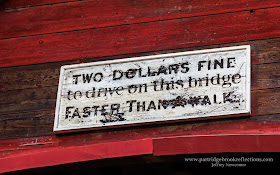Green River, Guilford, Vermont
Despite years of exploring the New England landscape, I am still surprised by the rich variety of photographic opportunities. There is always something new that I had never seen before. I know that the new stuff was always their, but the "seeing" part takes time, with differing seasons and the constantly evolving light.
 |
| Green River Timber Crib Dam and Falls |
 The Green River tumbles its way through Guilford in the southeast corner of Vermont. About 2.5 miles southwest of Guilford Center, the Jacksonville Stage Road crosses the river on a classic old covered bridge. The bridge is the focal point of Green River Village, which is quintessential New England. I try not to use the word “quintessential” more than once or twice a year, but Green River combines all the iconic New England elements in a lovely, undeveloped setting, what other word could I use ?
The Green River tumbles its way through Guilford in the southeast corner of Vermont. About 2.5 miles southwest of Guilford Center, the Jacksonville Stage Road crosses the river on a classic old covered bridge. The bridge is the focal point of Green River Village, which is quintessential New England. I try not to use the word “quintessential” more than once or twice a year, but Green River combines all the iconic New England elements in a lovely, undeveloped setting, what other word could I use ?From one spot overlooking the bridge you can absorb the beauty of the 1838 Green River Church, the Green River Bridge House B&B, a lovely red barn on the hill, and the Green River Falls as it tumbles over an unusual timber crib dam. Both the bridge and the dam are on the National Registry of Historic Sites. . And did I mention that all the roads are dirt, not a single yellow line to spoil the mood. the village is much more than a collection of individual attractions, but each deserves a brief mention.
 Green River Covered Bridge
Green River Covered BridgeThe Green River Bridge was built in 1873 and is 104 feet long. For more than a century the bridge has been a key part of the little community. In the past, the village mailboxes lined the walls. They're gone now, but there is still a nice view of the falls through the trusses, and it is still a great place to steal a kiss from your honey without all the neighbors knowing. A sign above the bridge warns that you will risk a two dollar fine if you cross faster than a walk, but don't worry, everything about Green River says "slow down and relax".
Green River Timber Crib Dam and Falls
 |
| Timber Crib Dam |
 |
| Under the Falls |
 |
| Green River Bridge House |
Green River Bridge House
The Green River Bridge is a lovely B&B. Built in 1830, the house has always been an integral part of the village, including having housed the local post office. The House offers three uniquely decorated guest rooms, which complement the warm and friendly atmosphere. The grounds parallel the Green River providing unique perspective on the bridge, just up stream.
 |
| There Must be a Red Barn |
The Red Barn
Beyond the bridge and just up a hill is a lovely farm house and our necessary roadside red barn.
 |
| Green River Church |
Green River Church
Of course the scene would be incomplete without a village church. Built in 1838, The Green River Church is a classic New England house of worship, strong, sparse and relentlessly white. It sits on a small hill overlooking and tirelessly guarding the village.

It is unique to find all these New England icons clustered in one small area, but what is truly remarkable is how they all work together. The place is a compositional playground for photographers, with endless opportunities to combine the features into perfectly balanced images that scream "New England". No matter how many times I return to Green River, I always find new ways to mix the changing seasons, the light and the icons to capture everything from grand landscapes to fascinating details. Come by and check it out. It is not easy to find, but well worth a wander off the beaten path.
Location:
To reach Green River take exit 1 off of I 91 in Brattleboro, Vermont. Travel about 1.4 miles south on US5 to Guilford then take the right toward Guilford Center for about 4.1 miles to the little Center. Shortly after the "Center" take a right on Stage Road. Travel 2.4 miles to the bridge.
When you finally acknowledge that you are lost, try the GPS Coordinates:
Latitude. N 42 46.532
Longitude W 72 40.015



































